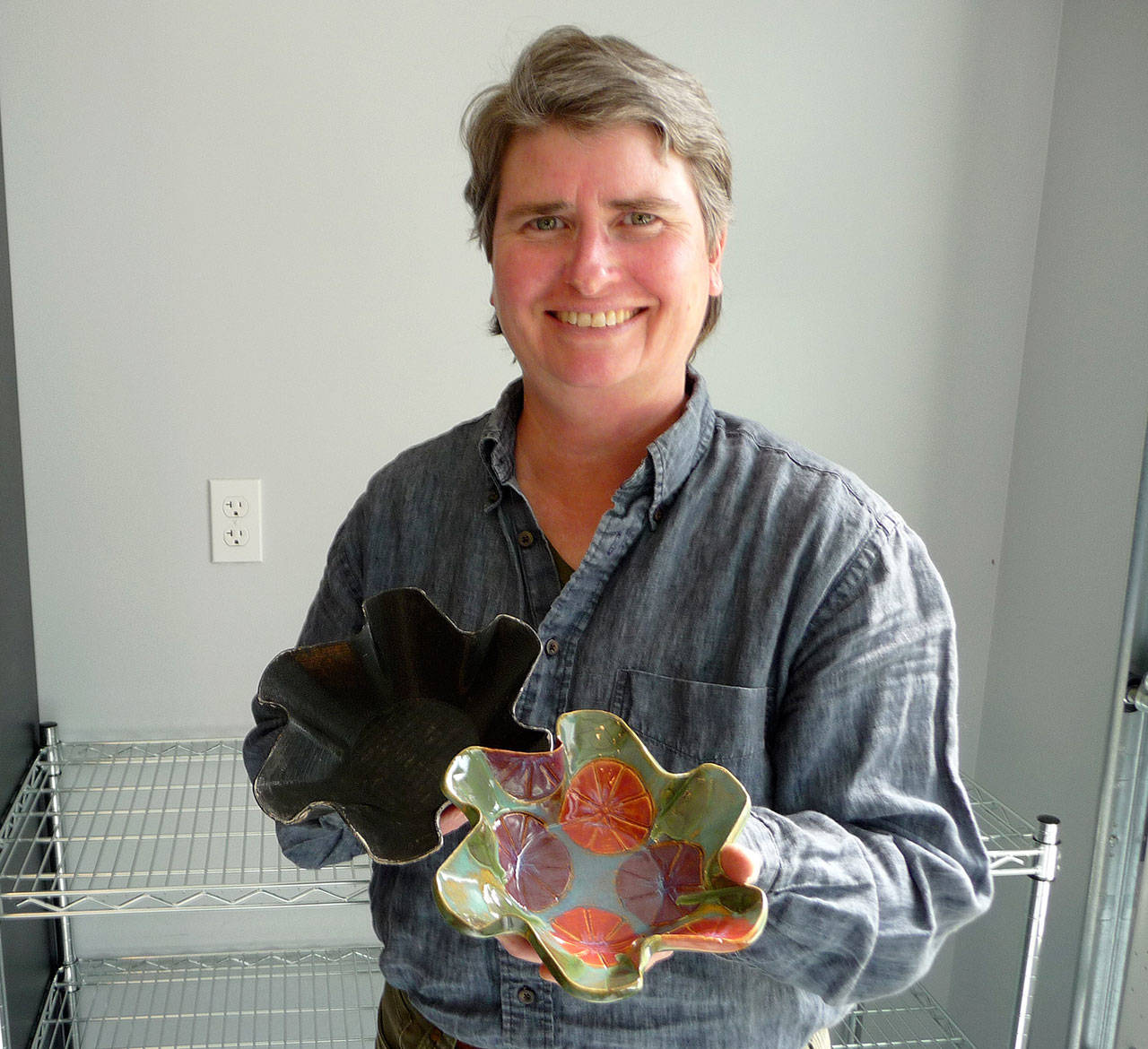Design2Scan3D
Location: 207 W. Spruce St., Sequim
Phone: 360-207-4156
Hours: By appointment only; 9 a.m.-5 p.m. Monday-Friday
On the web: www.design2scan3d.com
Stoneware Plate/Bowl Class in 2 sessions
2-4 p.m. May 1 — Molding & Texturing
2-4 p.m. May 29 — Glazing
Also, 6-8 p.m. June 12 and July 10
Fee applies
Sign up at www.Design2Scan3D.com
From aerospace engineer to artist: some might say that’s a quantum leap. For Chris Kresa, however, the two career paths are more compatible than they might seem.
Five years after leaving her 25-year career in Seattle as an avionics design engineer, Kresa realized she missed the creative process. She looked into 3D printing because, as the industry touted, there’d be such a printer “on every desktop.”
Three-dimensional or 3D printing was invented in the 1980s, has been used in manufacturing since the 1990s and came into personal use about 2011, according to www.omnicoreagency.com.
“I really enjoyed engineering,” Kresa said, “so I wanted to have fun with it this time around and using 3D printing and scanning with ceramics was a way to create functional art and a more enjoyable experience.”
She established Design2Scan3D in 2018.
Kresa was well-versed in CAD — or computer-aided design — so instead of aeronautical parts she turned her skills to building lightweight molds for creating ceramics.
“We’ve been making ceramics for thousands of years and used to use heavy plastic molds; this is a way to replace that,” Kresa said.
She explained that once a design is inputed from a CAD printable file, her professional 3D printer uses spools of black polylactic acid filament to form the object, layer upon layer.
“The printer breaks every piece into layers, raises a bit and prints the next layer until you have a series of layers that creates a 3D part — it’s called additive technology,” Kresa said. “And with my printer’s build space, I can make parts up to 11 inches.”
She opened up the file for a fan bowl mold and with a quick click highlighted the bowl’s bottom, the first layer to be printed. Kresa said this 8-inch wide by 2-inch deep part has 199 layers and would take about eight hours to print.
“There’s nothing fast about it — but there’s nothing fast about clay either — so they go well together,” Kresa said, noting after a clay piece is molded, it must be fired twice very slowly with a drying period of several weeks between each.
“We use two types of clay: earthenware (terra cotta) for the ollas, which is more porous and provides the seeping action that makes the ollas good watering devices, and stoneware for the dinnerware which is stronger and more chip- and crack-resistant than earthenware.”
With some pieces, clay is rolled out to the desired thickness and laid over the mold; with others it’s cut in cookie-cutter style to make round pieces such as cups. Design2Scan3D has 14 proprietary molds, a dozen or so texture tools and 12 colors of glazes, so that every piece imagined is unique.
All of the molds, tools and stamps are original designs by Kresa and her wife, Felicia Mueller.
One of Kresa’s favorite functional vessels is a terra cotta olla (Spanish for jar).
“It’s a clay pot for irrigation which you bury up to its neck and fill,” Kresa said. “It will water a 2-foot by 2-foot area and lasts about seven days because the water is released gradually. You just roll out the clay, cover the mold on both sides, smooth the sides and fire.
“I’ve been having so much fun with it, I think others will, too.”
And that’s not all
Whether it’s a person or a piece of plastic, Kresa can scan the entity. Immortalize yourself, like Sequim mayor Dennis Smith did at her request, with a tiny but finely detailed bust. Or, have her scan a broken bracket or cracked knob for a good-as-new replacement.
Parts that are plastic can be reproduced at the studio but not metal ones.
To scan an object, Kresa uses a device called a structure sensor that clamps onto an iPad.
“The color camera on the iPad then couples with the laser camera in the sensor,” Kresa said, noting she can scan the object in all 360 degrees.
“It takes a while to wrap your head around the kinds of things we can do — for example, with a broken bracket, I can glue it together, scan it and make a new part,” she said. “I want to have a class for people where everyone comes in to fix a broken part, as a hub where people can get parts that they can’t find on Amazon.”
Demos and classes
Design2Scan3D will be at the Shipley Center’s spring bazaar on April 27 and on the First Friday Art Walk Sequim on May 3 at the studio, 207 W. Spruce St.
Kresa is offering two ceramics classes this spring and early summer and plans to offer more. (See box.)
“People just lose themselves in clay, in the flow of it. Ceramics are in our DNA and even people with no ceramics experience have a great time. It’s good muddy fun!” she said.
At Design2Scan3D, all you have to ask is, “What do you want to create today?”



